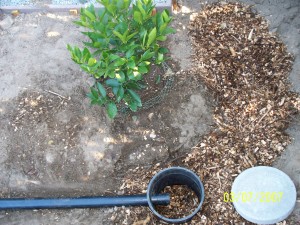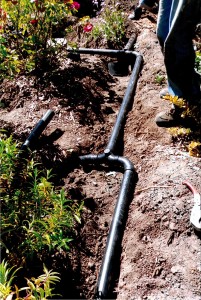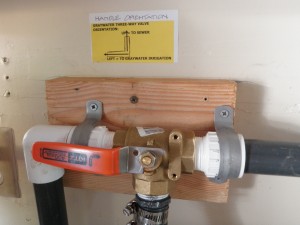California Greywater and Rainwater Reuse Law
Greywater is waste water from laundry machines, bathroom sinks, showers, and bathtubs. California law does not allow greywater use from kitchen sinks or dishwashers. In January 2010, the California Building Standards Commission adopted greywater guidelines into the California Plumbing Code. Guidelines for indoor, non-potable reuse of rainwater were incorporated into the code in 2012. The alternate water reuse chapters of the California Plumbing Code facilitate water conservation, make legal compliance easily achievable, and provide guidelines for avoiding potentially unhealthful conditions. The California Plumbing Code requires a construction permit for any greywater system that makes changes to a home’s drain/waste plumbing connected to clothes washers, showers, bathtubs, and bathroom sinks. The code allows residential graywater landscape irrigation from washing machines without a construction permit if the system meets all performance guidelines in the code (see Greywater System Requirements below). Watch this short video overview of the Laundry to Landscape system.
Designing Your System
The most reliable, economical, and low-maintenance greywater system designs require no pumps, filters, or storage tanks. Greywater is piped directly to the receiving landscape and distributed into mulch basins. The biology of the mulch basin and surrounding soil is the treatment system that digests organic debris, soap, and any potential pathogens.
Whereas laundry-to-landscape systems use the clothes washer’s internal pump to distribute greywater to mulch basins, branched drain systems from bathroom sinks, showers, tubs, and interior laundry rooms rely on gravity to send greywater into mulch basins through a branched drain irrigation system. Landscapes that are flat or uphill from the greywater source may require an effluent pump system. Greywater to drip irrigation is possible, but requires pumping, filtration, and backflow prevention, all of which increase overall system cost and maintenance. To learn more about greywater irrigation system design, visit our Technical Resources page, or:
Join the 1000 Greywater Systems Challenge!
- Register for one of our workshops! Design and install a laundry-to-landscape greywater irrigation system at your home.
- Hire a greywater installer! Get professional help from a Central Coast Greywater Alliance member for a more complex system.
Greywater System Requirements
All greywater irrigation systems must comply with the following guidelines to protect the environment and avoid system failure:
■ Any greywater system that includes a connection to a potable or municipal water supply must have an approved, backflow prevention device. Laundry to landscape greywater irrigation systems that are exempt from permitting must have no connection to the potable water supply or an external pump.
■ The greywater system design must include an accessible, clearly labeled, three-way valve that diverts the greywater back to the building sewer. Greywater should be diverted to the building sewer during the rainy season between November and April.
■ The greywater must not leave the property where it came from or come within 100 feet of any creek, wetland, or waterway.
■ The groundwater table must be lower than 3 feet from the lowest greywater irrigation or disposal point.
■ Each release point of the greywater irrigation system must be covered with at least 2¨of mulch, rock, soil, or a soil shield. Sprinkler irrigation and ponding of greywater are not allowed!
■ Water used to wash diapers or other infectious garments must be diverted to the building sewer.
■ Greywater may not contain hazardous chemicals.
■ Greywater may not be used to irrigate root crops or other edible crops that touch the soil.
■ An operations and maintenance manual for the greywater system must be provided by the installer and must be transferred to the new tenant or owner for the life of the greywater system.
■ Greywater irrigation systems must be located a minimum horizontal distance away from the following landscape features:
| Landscape Feature | Minimum Horizontal Distance from Greywater Irrigation System |
| Building structures | 2 ft |
| Property line adjoining private property | 1.5 ft |
| Water supply wells | 100 ft |
| Streams, Rivers, Lakes, Wetlands, and High Tide line of Ocean | 100 ft |
| Sewage pits or cesspools | 5 ft |
| Sewage disposal field | 4 ft |
| Septic tank | 5 ft |
| Onsite domestic water service line | 0 ft |
| Pressurized public water main | 10 ft |
For detailed information regarding required setbacks for greywater tanks, greywater irrigation fields, and greywater disposal fields, see Table 1503.4 of Chapter 15 of the California Plumbing Code.


